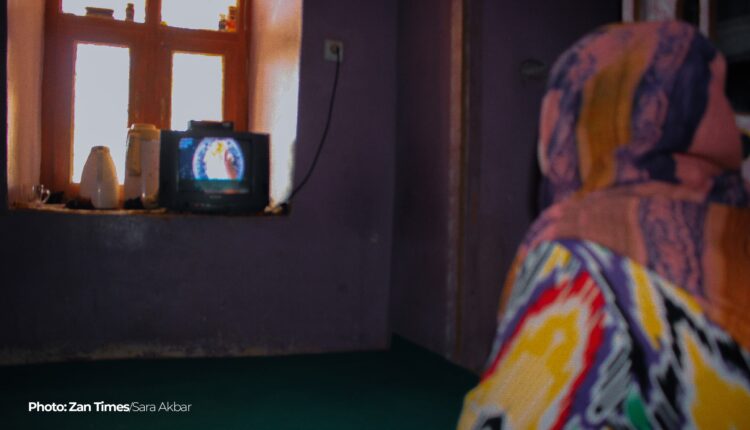
100-plus television stations shut down during past year
This story first appeared in Zan Times
By Freshta Ghani
Ahead of this year’s World Television Day on November 21, Nai Supporting Open Media, a media advocacy group in Afghanistan, reveals that more than 100 television networks have stopped operating in Afghanistan since the Taliban takeover of the country in August 2021.
One of the latest to shut down is Kabul News television network, which stopped operating just a few weeks ago. This organization began in 2011 and mainly covered news and political affairs.
Mansoor Nikmal, the news editor of Kabul News, tells Zan Times that the operation has temporarily stopped due to limitations and financial problems.
Although Nikmal does not explain what these “limitations” are, another employee of Kabul News who requested to remain anonymous due to security reasons, tells Zan Times that the main reason for the closure of Kabul News was the Taliban’s direct interference with its programs. This source adds, “Although we had financial problems, it wasn’t so bad that would make us stop our activities. We were going to air some reports that the Taliban wouldn’t allow us. One or two of these reports were about the secret deals of the Taliban on the Durand Line and arms trafficking.”
This source says that they were under pressure from the Taliban because of their work. “The Taliban would call us after airing every newscast and ask us why we had aired the news before they approved it,” explains an employee of Kabul News.
According to this source, the Taliban strictly censors news about women’s protests. “When we broadcast footage of female students protesting in Badakhshan province a while ago, several Taliban agencies contacted us and warned us that we were not permitted to broadcast anything like that,” says this person.
It is due to such interference by the Taliban that many media outlets have ceased their activities in Afghanistan. Zarif Karimi, the head of Nai, tells Zan Times that only 89 television stations are active, compared to 198 that were working before the Taliban takeover.
That’s a sharp plunge in numbers, but still a far cry from the one network that was on the air when the previous Taliban regime collapsed in 2001. Since then, the media industry has flourished, in part due to support from the international community.
As well as the number of stations being cut by more than half, Karimi notes that the restrictions imposed on media by the Taliban have drastically affected the quality of television programs. He says that there isn’t diversity in the programs produced by television networks in Afghanistan, in part because all media are compelled to make sure their programs are in line with Taliban policies.
So far, the Taliban has issued two directives for television networks in Afghanistan. In their first, issued in November 2021, women were banned from appearing in dramas or satire programs, and female newscasters were ordered to observe Islamic hijab. As well, the networks were ordered not to broadcast domestic or foreign shows deemed by the Taliban to not be in line with the culture of Afghanistan or if they would spread “immorality” in the society.
This directive also banned drama series that the Taliban believed were against Islamic sharia or that insulted religious practices.
In May 2022, the Taliban issued a second directive, which required women broadcasters to cover their faces so that only their eyes could be seen while they were on air. As well, they were forbidden from interviewing male guests on a TV programs.
Following that second directive, many women broadcasters left their jobs. On October 1, Lima Espisilai, who worked at One TV, wrote on her Facebook page that she’d finished her last day at that job. “The main reason I left my job was the increasing restrictions that the Taliban imposed on us,” Espisilai says in an interview with Zan Times. “I couldn’t stand it anymore to be humiliated or accept new restrictions every day just because of being a woman. Although I have no escape from Afghanistan, I had to leave my job.”
Nevertheless, many female broadcasters and journalists have continued to work despite the increasing number of restrictions. Hosai Ahmadzai, a broadcaster of Shamshad TV, tells Zan Times that the most difficult part of her job is hosting a one-hour program with her mask on. “I cannot breathe properly during the program with a mask on my mouth, but I am not allowed to remove it,” she explains. “It makes it difficult to communicate with the guest when I cannot breathe. This really upsets me.”
Now after a year and half of Taliban rule, in most recent response to the Taliban’s repression of media, the World Media Freedom Coalition (MFC) announced that Afghanistan’s membership in the coalition has been cancelled.
“Since seizing power, the Taliban have imposed serious restrictions on media freedom that have threatened the safety and well-being of journalists and media workers,” it explained. “It is clear to the MFC that the situation of media freedom in Afghanistan is, unfortunately, no longer in line with the Global Pledge. Indeed, the current state of affairs is one of grave concern,” stated the coalition on Friday, November 18.
Afghanistan became a member of the World Coalition for Media Freedom in 2020. The member countries in this coalition pledged to fulfill global obligations in the field of freedom of expression.
Freedom of speech and media activities have faced serious restrictions after the Taliban came to power. In more than a year since seizing power, the Taliban has subjected journalists and media workers to violence, threats, and arrests. The World Coalition for Media Freedom has emphasized that the harassment, attacks, arrests of journalists, and expulsion of women from the media have caused the independence of the media to be violated.
